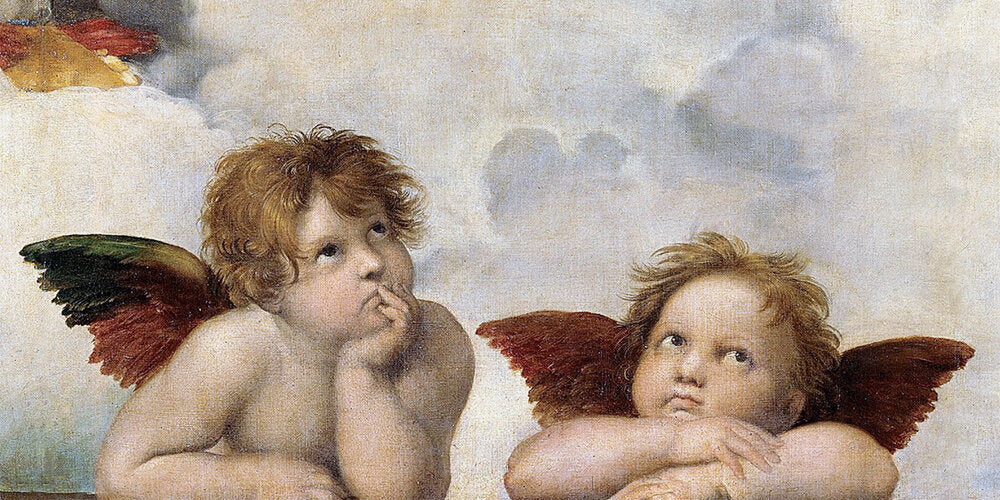Feature image: The Two Cherubs, part of Raphael's Sistine Madonna, 1513, via OnVerticality
The Artistic Roots of Sonny Angel
Sonny Angel figures are Gen Z’s latest obsession, with Buzzfeed and the New York Times featuring them in 2023. Sonny Angels’ explosion in popularity may seem out of the blue, but their design takes inspiration from the familiar.
These cherubic dolls draw influence from a popular 20th-century comic strip character and from classical depictions of angels, creating a feeling of childhood nostalgia for Gen Z-ers entering the working world. Many centuries of art history lie beneath the angelic surface of Sonny Angels’ faces.

What are Sonny Angels?
Sonny Angels are three-inch tall figures of a chubby little boy angel (named Sonny, of course) who wears different headgear and outfits. With their side-eyeing smirk, round face, and little pair of angel wings, it’s hard not to let Sonny Angels—and their collectability—grow on you.
Sonny Angels are released in limited, themed series to include animals, fruits, flowers, and sweets. Each series contains six to 12 different collectible figures, which, disguised in their indistinguishable packaging, remain a mystery until the box is opened. In addition to the main set of figures, there is also a “secret,” unadvertised figure and a “Robby Angel,” a rat-like creature who is Sonny’s companion.

Created by the Japanese toy company Dreams, Sonny Angel debuted in 2005. The dolls have enjoyed a recent resurgence in popularity thanks to their internet virality on platforms like TikTok, Instagram, and Reddit. According to the aforementioned New York Times article, Sonny Angel was “designed to be a tiny companion for working women in their mid-20s dealing with the stresses of adulthood.”
This specific demographic is propelling Sonny Angel into the mainstream within the United States. Videos of unboxings, hauls, and trading meetups have gone viral across the internet, with Sonny Angels quickly selling out at retailers like Urban Outfitters and Sonny Angel’s official online site.
Although Sonny Angels are a fairly new creation, they’re a spiritual successor to another angel doll that is an iconic part of 20th-century Americana.

The Kewpie Connection
If Sonny Angel looks familiar to you, you’re not imagining it. His nude appearance and his cartoonish face make him look a lot like the “original” collectible angel doll, Kewpie. The New York Times notes that the resemblance between the two was “striking.”
Created by Rose O’Neil in 1909, Kewpie was originally a comic strip character. Meant to be a “baby Cupid,” Kewpie was first seen in Ladies’ Home Journal after O’Neil was asked to create “a series of little creatures,” according to Smithsonian Magazine. The public loved Kewpie’s cheeky, cute appearance, and toy factories quickly contacted O’Neil to create Kewpie figures.
The first Kewpie figure was created in 1912, and the rapid success of the figures, in addition to O’Neil’s comics, made her the highest-paid female illustrator in the country by 1914. Later in the 1910s, O’Neil began to feature Kewpie in her works which advocated for women’s suffrage. Smithsonian Magazine quotes Laura Prieto, a history professor at Simmons College, as saying, “Kewpies helped the suffrage movement combat the stereotype of a feminist as old, ugly, and anti-men.”
Kewpie dolls spread in popularity across the world, so much so that in the 1920s, unlicensed reproductions of the doll began to be made in Japan. Japan fell so in love with Kewpie that his name was even used for the Kewpie Mayonnaise brand.
Although no direct connection between Kewpie and Sonny Angel has been confirmed, it’s not a stretch to say that Sonny Angel’s creator, Toru Soeya, might have been influenced by the American character that infatuated Japanese culture.
Kewpie and Sonny Angel have more in common than their visual designs, though. Both are derivatives of classical religious iconography.

Cherubs in Art
“Why are they naked and anatomically correct?” is probably the first question some will have when looking at a Sonny Angel for the first time. Luckily, there’s a logical answer: they’re cherubs.
What’s a cherub? In Abrahamic religions, a cherub is “a celestial winged being with human, animal, or birdlike characteristics who functions as a throne bearer of the Deity,” according to Britannica. In other words, an angel. Their appearance as chubby, winged male toddlers has, of course, been infinitely replicated in artistic works. The cherub sometimes goes by other names, like the Italian “putto”, a general term for winged babies or, drawing from Greek mythology, “cupid,” which is a more accurate descriptor for the Kewpie character.
In art, cherubs are typically depicted “flying around the edges of religious scenes in art, flanking the pious,” notes Getty. In Raphael’s 1513-1514 work, Sistine Madonna, two cherubs grace the bottom of the painting, gazing up at the Virgin Mary. Cherubs were a common motif in Renaissance art and were prominently featured in Donatello's works. They represent purity, innocence, and youth.
Sonny Angel collectors might, knowingly or not, connect with these values as they seek the whimsical, child-like happiness that Sonny Angel figures provide.
Conclusion
Whether Sonny Angels are just a fad or will become as beloved and recognizable as Kewpie remains to be seen. It’s no surprise, though, that both brands have pulled from religious concepts like the cherub, which are iconic symbols of Renaissance art.
So, next time you see a Sonny Angel in the wild or on your TikTok feed, you’ll know their deeper origins. Plus, you’ll have an answer as to why they’re naked.
©ArtRKL™️ LLC 2021-2024. All rights reserved. This material may not be published, broadcast, rewritten or redistributed. ArtRKL™️ and its underscore design indicate trademarks of ArtRKL™️ LLC and its subsidiaries.







